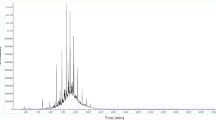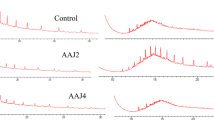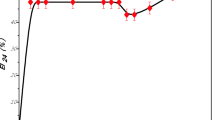Abstract
Accumulation of oily sludge is becoming a serious environmental threat, and there has not been much work reported for the removal of hydrocarbon from refinery tank bottom sludge. Effort has been made in this study to investigate the removal of hydrocarbon from refinery sludge by isolated biosurfactant-producing Pseudomonas aeruginosa RS29 strain and explore the biosurfactant for its composition and stability. Laboratory investigation was carried out with this strain to observe its efficacy of removing hydrocarbon from refinery sludge employing whole bacterial culture and culture supernatant to various concentrations of sand–sludge mixture. Removal of hydrocarbon was recorded after 20 days. Analysis of the produced biosurfactant was carried out to get the idea about its stability and composition. The strain could remove up to 85 ± 3 and 55 ± 4.5 % of hydrocarbon from refinery sludge when whole bacterial culture and culture supernatant were used, respectively. Maximum surface tension reduction (26.3 mN m−1) was achieved with the strain in just 24 h of time. Emulsification index (E24) was recorded as 100 and 80 % with crude oil and n-hexadecane, respectively. The biosurfactant was confirmed as rhamnolipid containing C8 and C10 fatty acid components and having more mono-rhamnolipid congeners than the di-rhamnolipid ones. The biosurfactant was stable up to 121 °C, pH 2–10, and up to a salinity value of 2–10 % w/v. To our knowledge, this is the first report showing the potentiality of a native strain from the northeast region of India for the efficient removal of hydrocarbon from refinery sludge.





Similar content being viewed by others
References
Abdel-Mawgoud AM, Aboulwafa MM, Hassouna NA (2009) Characterization of rhamnolipid produced by Pseudomonas aeruginosa isolate Bs20. Appl Biochem Biotechnol 157:329–345
Abdel-Mawgoud AM, Lépine F, Déziel E (2010) Rhamnolipids: diversity of structures, microbial origins and roles. Appl Microbiol Biotechnol 86:1323–1336
Arino S, Marchal R, Vandecasteele JP (1996) Identification and production of a rhamnolipid biosurfactant by a Pseudomonas species. Appl Microbiol Biotechnol 45:162–168
Banat IM (2000) Les biosurfactants, plus que jamais sollicités. Biofutur 198:44–47
Banat IM, Samarah N, Murad M, Horne R, Banerjee S (1991) Biosurfactant production and use in oil tank clean-up. World J Microbiol Biotechnol 7:80–88
Beal R, Betts WB (2000) Role of rhamnolipid biosurfactants in the uptake and mineralization of hexadecane in Pseudomonas aeruginosa. J Appl Microbiol 89:158–168
Bondarenko O, Rahman PKSM, Rahman TJ, Kahru A, Ivask A (2010) Effects of rhamnolipid from Pseudomonas aeruginosa DS10-129 on luminescent bacteria: toxicity and modulation of cadmium bioavailability. Microb Ecol 59:588–600
Bordoloi NK, Konwar BK (2009) Bacterial biosurfactant in enhancing solubility and metabolism of petroleum hydrocarbons. J Hazard Mater 170:495–505
Cameotra SS, Singh P (2008) Bioremediation of oil sludge using crude biosurfactants. Int Biodeter Biodegr 62:274–280
Costa SGVAO, Deziel E, Lepine F (2011) Characterization of rhamnolipid production by Burkholderia glumae. Lett Appl Microbiol 53:620–627
Das K, Mukherjee AK (2007) Crude petroleum-oil biodegradation efficiency of Bacillus subtilis and Pseudomonas aeruginosa strains isolated from a petroleum-oil contaminated soil from North-East India. Bioresour Technol 98:1339–1345
Haba E, Pinazo A, Jauregui O, Espuny MJ, Infante MR, Manresa A (2003) Physicochemical characterization and antimicrobial properties of rhamnolipids produced by Pseudomonas aeruginosa 47T2 NCBIM 40044. Biotechnol Bioeng 81:316–322
Hassan BH, Cronan JE (2011) Protein-protein interactions in assembly of lipoic acid on the 2-oxoacid dehydrogenases of aerobic metabolism. J Biol Chem 286:8263–8276
Jenkins TC, Thies EJ, Mosley EE (2001) Direct methylation procedure for converting fatty amides to fatty acid methyl esters in feed and digesta samples. J Agri Food Chem 49:2142–2145
Joseph PJ, Joseph A (2009) Microbial enhanced separation of oil from a petroleum refinery sludge. J Hazard Mater 161:522–525
Kim H, Yoon B, Lee C, Suh H, Oh H, Katsuragi T, Tani Y (1997) Production and properties of a lipopeptide biosurfactant from Bacillus subtilis C9. J Ferment Bioeng 84:41–46
Koch AK, Kappeli O, Fiechter A, Reiser J (1991) Hydrocarbon assimilation and biosurfactant production in Pseudomonas aeruginosa mutants. J Bacteriol 173:4212–4219
Kuriakose AP, Manjooran SKB (1994) Utilization of refinery sludge for lighter oils and industrial bitumen. Energ Fuel 8:788–792
Lima TMS, Fonseca AF, Leão BA, Mounteer AH, Tótola MR, Borges AC (2011) Oil recovery from fuel oil storage tank sludge using biosurfactants. J Bioremed Biodegrad 2:125. doi:10.4172/2155-6199.1000125
Patel RM, Desai AJ (1997) Surface-active properties of rhamnolipids from Pseudomonas aeruginosa GS3. J Basic Microbiol 37:281–286
Pornsunthorntawee O, Wongpanit P, Chavadej S, Abe M, Rujiravanit R (2008) Structural and physicochemical characterization of crude biosurfactant produced by Pseudomonas aeruginosa SP4 isolated from petroleum contaminated soil. Bioresour Technol 99:1589–1595
Rahman KSM, Rahman TJ, McClean S, Marchant R, Banat IM (2002) Rhamnolipid biosurfactant production by strains of Pseudomonas aeruginosa using low-cost raw materials. Biotechnol Prog 18:1277–1281
Saikia RR, Deka S, Deka M, Banat IM (2011) Isolation of biosurfactant producing Pseudomonas aeruginosa RS29 from oil-contaminated soil and evaluation of different nitrogen sources in biosurfactant production. Ann Microbiol 62:753–763
Saikia RR, Deka S, Deka M, Sarma H (2012) Optimization of environmental factors for improved production of rhamnolipid biosurfactant by Pseudomonas aeruginosa RS29 on glycerol. J Basic Microbiol 52:446–457
Santos AS, Sampaio AW, Vasquez GS, Santa Anna LM, Pereira N, Freire MG (2002) Evaluation of different carbon and nitrogen sources in production of rhamnolipids by a strain of Pseudomonas aeruginosa. Appl Biochem Biotechnol 98:1025–1035
Thaniyavarn J, Chongchin A, Wanitsuksombut N, Thaniyavarn S, Pinphanichakarn P, Leepipatpiboon N, Morikawa M, Kanaya S (2006) Biosurfactant production by Pseudomonas aeruginosa A41 using palm oil as carbon source. J Gen Appl Microbiol 52:215–222
Acknowledgments
We thank the director of IASST, Guwahati for providing us laboratory facilities to carry out the research work. The corresponding author gratefully acknowledge the Department of Biotechnology, Government of India for providing fellowship to carry out the research under the project sanction vide letter no. BT/PR 9795/BCE/08/590/2007 to the second author of the manuscript. We also thank Dr. D.J. Hazarika and Mr. S. Dey for their assistance in analyzing the sample through LC-MS and GC-MS, respectively.
Author information
Authors and Affiliations
Corresponding author
Additional information
Responsible editor: Philippe Garrigues
Rights and permissions
About this article
Cite this article
Saikia, R.R., Deka, S. Removal of hydrocarbon from refinery tank bottom sludge employing microbial culture. Environ Sci Pollut Res 20, 9026–9033 (2013). https://doi.org/10.1007/s11356-013-1888-2
Received:
Accepted:
Published:
Issue Date:
DOI: https://doi.org/10.1007/s11356-013-1888-2




